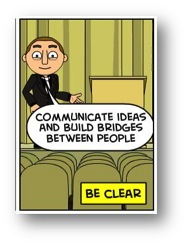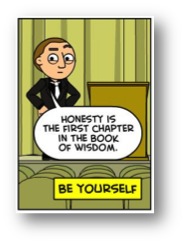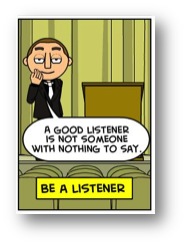The main characteristic of human interaction, and presentations for that matter, is verbal communication. It covers just about all aspects of human activity: it is used to inform, to intimidate, to promise, to scare, to entertain, to threaten, and so on. Regardless of how much emphasis you have placed on technology to enhance your message, how much care you have invested in researching and preparing your content, how much attention you have paid to your gestures, your posture and your facial expressions, it all comes down to how you say it. Loudness, tone, enunciation, pauses, emphasis, word choice are some of the aspects of oral communication, some of the tricks the speaker can use to enhance the spoken word.
Barely making yourself heard as opposed to speaking above everybody else carries a different amount of weight in a social setting. Your voice can express conviction, fear, certainty, doubt and so on depending on the tone of your voice. In addition, how clearly and distinctly you articulate words and, consequently, your thoughts has a different impact on your audience. The speed of your speech, as well as the opportunities you give your audience to appreciate what you have just said by pausing greatly impacts your message. Furthermore, you can add emphasis by changing the tone of your voice or varying the speed of delivery. Most importantly, you can deliver the same message to a variety of audiences by making different word choices (and sentence structures) to match their background and experiences.
As a speaker, it is important to remember that whether giving a presentation or talking to a friend, whether teaching a group of learners or interviewing a teacher, whether enjoying coffee with a colleague or negotiating a deal, “A species' survival depends critically upon its ability to communicate effectively, and the quality of its social life is determined in large measure by how and what it can communicate. Human social life as it is presently constituted is predicated upon an extraordinary level of communicative virtuosity – a level of virtuosity that the uniquely human ability to use language confers. Absent this, our lives would be quite different.”
George Drivas, Director of Studies, Department of Foreign Languages
BE FRIENDLY
 As a speaker, you need to be favorably disposed towards your audience; you need to be inclined to appreciate their idiosyncrasies, to help them understand your message, or support them when they express doubt or disbelief.
As a speaker, you need to be favorably disposed towards your audience; you need to be inclined to appreciate their idiosyncrasies, to help them understand your message, or support them when they express doubt or disbelief.
This approach has a social and a functional dimension.
Socially, we are drawn to people who are polite and welcoming. We respond positively to people who make us feel comfortable and at ease. We tend to open up to them and what they have to say.
Functionally, we identify with people who understand and appreciate our needs and expectations. “When planning an important communication, the focus should be on language, because it’s language that governs thought, persuasion, and the perception of character, attitudes and values” (Blake,1987, p. 43). Language does more than just convey meanings, communicate facts and lead to conclusions. It helps listeners define their perception of the speaker and, consequently, of what is being said.
Tip #1: Attention to tone of speech. Be polite and welcoming. At the beginning of your presentation, introduce yourself and acknowledge your audience as is appropriate. Comment on their professional setting, asking about how this is similar or different from yours. During your presentation, encourage comments about their experiences and how they relate to the points you are making. Single out a reaction, i.e., a nod or a smile, and elicit a verbal response. At the end of your presentation, thank them for their presence and attention and encourage questions.
Tip #2: Attention to word choice. The words we use in our communication are defined to a large extent by our social, ethnic and cultural background and heritage. The words we use are also determined by our education and training. Stereotypes that are acceptable to one group of people may be insulting to another. Enter "political correctness". It can be defined as a conscious attempt to avoid racist and sexist language and comments that can be detrimental to your effort to convey your real message. During your presentation, identify character attributes and social values that are considered universal such as honesty and health. Use neutral terms as far as possible. Be firm but not dogmatic. When in doubt, ask a question instead of making a statement.
BE CLEAR
 Your speech, and your language, needs to be free from obscurity and sharply defined.
Your speech, and your language, needs to be free from obscurity and sharply defined.
Both these qualities should be reflected in your delivery as well as your content.
In terms of delivery, special attention should be paid to enunciation and loudness. Words must be carefully enunciated so that the audience can understand what is being said. One of the greatest errors made by speakers is speaking so fast that they lose the ability to enunciate properly. As a rule of thumb, slow is better than fast. In addition, you must speak loudly enough. Again, if the audience cannot hear you, then all is lost. Regulating the volume of your voice is important. Variations in volume can communicate a great deal of meaning. Think about what a whisper conveys. In contrast, think of a loud shout. Volume and rate of speech are the functional equivalents of italicized or bolded words in a written text.
In terms of content, consider the following: "A fundamental characteristic of language is its capacity to name things. During the naming process, language necessarily provides signification to the item and excludes everything else from that particular category. This provides both division and unity because it excludes certain factors as it allows a common understanding of previously disparate ones (Burke, 1969). " Each term you use, each description you make should closely define what you include as well as what you leave out. You need to be consistent so that your audience can follow you. You also need to pay attention to the reference you make. The easier they can relate to them the more they will appreciate what you have to offer. By contrast include as many technical terms as necessary but do not overdo it. You may want them to identify you as an expert. However, you do not want them to go away with the feeling that you were talking down to them.
Tip # 3: Attention to enunciation and loudness. There are two solutions to this: Practice and then practice some more. Record yourself and play back the recording. This can be an intimidating experience. Alternatively, you can rehearse your speech enlisting the help of a colleague. This process will help you identify which words or sentences or any combination of them causes difficulty. Is it rate of speed? Is it intonation? Is it tone of voice? Is it loudness? Try different variations and have a colleague help you out.
When rehearsing, always practice standing up. Focus on a point that is furthest from you and speak to it. If you are recording your practice, place the machine as far away from you as possible and then check that it can audibly capture what you are saying. At the beginning of your presentation, check with those sitting at the back if they can hear and understand you. If you are using a microphone keep a safe distance between it and your mouth and definitely speak more softly than you would without one. In both cases, make certain that you speak facing and looking at the audience.
Tip #4: Attention to word choice. In particular, use of technical terms or strings of initials. Their use is the natural development of common thinking among members of the same social, cultural or professional group. Their use may offer a feeling of common understanding, of solidarity. It can also be inhibiting to initiates or outsiders. When preparing your presentation, make certain that you use them sparingly depending on your audience. Technical terms or strings of initials are both prime candidates for inclusion in your slides. Read your audience’s reactions and be prepared to offer a short definition or an example. As a rule of thumb, rehearse with a colleague and/or an acquaintance. When in doubt, explain.
BE CONFIDENT
 Your voice and speech should show no signs of uncertainty in your abilities or the correctness of your beliefs. Chances are that you have been selected to prepare and deliver a particular presentation. It is a sign that your supervisors and/or your peers have faith in you and what you stand for: your background and experiences. This acceptance did not happen overnight. You have proven your worth within your work environment. Think of them when preparing and practicing your presentation. Visualise their reactions and responses and adapt your performance accordingly during practice.
Your voice and speech should show no signs of uncertainty in your abilities or the correctness of your beliefs. Chances are that you have been selected to prepare and deliver a particular presentation. It is a sign that your supervisors and/or your peers have faith in you and what you stand for: your background and experiences. This acceptance did not happen overnight. You have proven your worth within your work environment. Think of them when preparing and practicing your presentation. Visualise their reactions and responses and adapt your performance accordingly during practice.
In particular, "Confidence is a self-assurance arising from an appreciation of one’s true abilities, whereas humility is having a modest opinion of one’s own importance. Speaking with confidence includes the words you choose, the tone of your voice, your eye contact, and body language."
Tip #5: Identify your abilities. Make a list of your strengths and weaknesses as a speaker and as a professional. The former should reflect how you deliver your content; the latter should reflect the content itself. When preparing your presentation, go through the list of strengths and identify how they are evidenced in your content. During practice, repeat the process focusing on delivery. Can your listeners identify all your strengths? Remember that there is no such thing as a perfect presentation. Everybody makes mistakes. This is why drafting and redrafting your presentation is paramount. This is why practicing and rehearsing is important; they provide you with a perfect opportunity to minimise your mistakes. During your presentation, simply, do not let them take over. If you feel comfortable about being human, your audience will focus on the positive aspects of your performance. If, on the other hand, you stall, if you constantly apologise or correct yourself, then you will stress the negative aspects of your performance.
Tip #6: Focus on contribution. Think of who you are and how hard you have worked to reach this point in your professional life. These are the reasons people have come to your presentation. They have come to appreciate what you have to offer. Focus on the members of your audience and what you have to present rather than on yourself and what you are getting out of this particular presentation. How can you make your massage more effective and more pleasant? If you were not there, would they be any wiser? Even if your presentation triggers a series of reactions or a series of objections, you have provided an opportunity for debate. This is not personal, it is professional. What is the basis of their comments? Could it be that you offered them too much too soon? Or is it the case that you offered them too little too late? In either case, it is all about them. Adapt and adjust during practice. Remember: the more you contribute to the world the more you’ll be rewarded with personal success and recognition.
BE CONCISE
 The basic principle to adhere to is that your speech should express or cover much in few words; you need to be brief in form but comprehensive in scope. Minimalism, a term used in art is the style in which the simplest and fewest elements are used to create the maximum effect.
The basic principle to adhere to is that your speech should express or cover much in few words; you need to be brief in form but comprehensive in scope. Minimalism, a term used in art is the style in which the simplest and fewest elements are used to create the maximum effect.
Your presentation should adopt this principle for the following reasons. First, think of how much your audience needs in order to understand your point rather than how much you need to say to make your point understood. They are successful professionals like yourself, so give them credit for that. Second, do not exhaust their patience. Get to the point of what you are trying to say fast and get them to process your message rather than the other way round.
Tip #7: Focus on your main points. During planning, identify the main points you are trying to make and share them with colleagues to test repetition and redundancy. Can your listener progress from one point to the next effortlessly? To what extent can they anticipate what is coming next? What is the ratio of points to be made compared to the time available? What are the explanations, examples and supporting data required? How many of each do you need? Do you need all three of them? Be ruthless with your plan when considering overlaps or redundancies. Remember your storyboard. It can be an invaluable tool during this process.
Tip #8: Use as few words as possible. During practice and rehearsing, stick to the following principles. First, keep your sentences short (with as few words as possible). You will know your sentences are longer than necessary if you are stating the obvious. Second, do not get sidetracked or distracted. You may have just thought of what you feel is the most interesting story or comment; however, is there room for it? Most importantly, can you find your way back to the point you were making without the help of your notes? Last, and perhaps most important, give your listeners what they can digest. During your presentation, if they are interested in more details of a particular point they will ask you for them. If you feel they might miss a particular point, ask them for an example, an explanation or their personal experience. Then you will know how to adapt to their expectations.
BE YOURSELF
 When speaking, it is important to be in your normal state of mind; it is important to be unpretentious, genuine and sincere. In other words, be authentic.
When speaking, it is important to be in your normal state of mind; it is important to be unpretentious, genuine and sincere. In other words, be authentic.
“Being authentic can be empowering. You will know that you are living a life with purpose, using your talents and skills productively, and doing it peacefully and harmoniously while contributing to the lives of those around you.”
In other words, being authentic can help you feel better and be more confident. You know who you are and what you can achieve. As a result, you can build solid and longer lasting professional, personal and social relationships. Furthermore, you can set clear targets by increasing your (self-) awareness by knowing what your next step could or should be and how to navigate around challenges and obstacles.
Tip # 9: Discover yourself. Draw up a list of points that you like about yourself professionally: attention to detail, as well as a list of points that you can develop. Ask a colleague or an acquaintance to do the same for you. Compare the two lists. It will give you an insight into how others see you. Check the points you agree with and the points you disagree with. Ask for clarification(s). Compile a final list prioritising the points from your friend’s and your personal list. Capitalise on the positive aspects of your character/ performance. Check those points that you can improve on. Are they within the range of your personal skills and values? How will they both help you achieve your targets? How do they influence the way others see you?
Tip #10: Delivering your presentation. During practice make certain that you allow the real you to emerge. Avoid reading aloud a scripted speech. This will alienate you from your audience and quite simply “put words in your mouth”. Try building on key words that appear on your slides, expanding on them and illustrating the points you are making using examples from your personal or professional experiences as if talking to yourself or a colleague. During your presentation, do not hesitate to deviate from your plan depending on what reactions or responses you are getting from your audience.
BE A LISTENER
 Pay attention to how your audience responds and what they need; show respect for their reactions and take them into account. A good speaker is one who reads his audience and adapts to their needs. He does not sidetrack. He does not abandon his aim. He does not remain silent. Rather, he responds to doubts or questions that may arise to make his message more specific, timely and relevant.
Pay attention to how your audience responds and what they need; show respect for their reactions and take them into account. A good speaker is one who reads his audience and adapts to their needs. He does not sidetrack. He does not abandon his aim. He does not remain silent. Rather, he responds to doubts or questions that may arise to make his message more specific, timely and relevant.
Tip #11: Acknowledging your audience. Here is a list of tips that you can use to achieve this. Consider them as a general guideline rather than a set plan.
• Use eye contact as much as possible. It will encourage your listeners to look at you in return and also give you the opportunity to read their reactions to what you are saying. However, do not stare at the same person all the time since this may have the opposite effect.
• Use inviting language and gestures when someone is making a comment, e.g., nodding. It will confirm that you are really paying attention and you are not just pretending. Open the question to the rest of the participants to gauge their interest and buy time to formulate an answer.
• Rephrase a comment that has been made for the benefit of everybody in the room. Link it to one of the points you have made or direct their attention to one of the points that are going to follow. Ask for possible alternatives to this comment. Thank that person accordingly.
• Do not interrupt or change the subject. Address the point as objectively and directly as possible based on the interest level of the other members in the group. If you feel that this comment concerns just one member in the audience ask them to see you at the end of the presentation so you can discuss it further.



